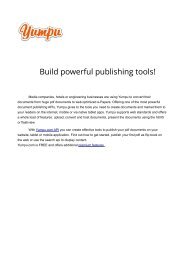test_pdf.pdf
You also want an ePaper? Increase the reach of your titles
YUMPU automatically turns print PDFs into web optimized ePapers that Google loves.
ASSESSING<br />
THE RECORD<br />
OF ARMS<br />
CONTROL<br />
takes individual soldier’s decisions, individual platoon commanders, and those things.<br />
That may not be a very good expression. The magnitude is so different and therefore people came to call them<br />
weapons of mass destruction.<br />
Indeed, there is also debate about the differences among the three categories, because nuclear, for instance, once<br />
it’s used there is virtually no way to protect. There is enormous force of destruction. There is no way you can protect<br />
yourself. But chemical or biological, with appropriate protective gear, you can still protect yourself even if the enemy<br />
has used them. So some people argue that there is even first-class WMD and second-class WMD. They’re not weapons<br />
of mass destruction. Analysis done by OTA [Office of Technology Assessments] in the early 1990s showed that<br />
even under the most optimistic scenarios, an aircraft delivering nerve agent would only produce, in the best circumstances,<br />
thousands of casualties, whereas the same aircraft delivering a payload of anthrax, for example, could<br />
produce casualties up to 2 million people. So I think biological, clearly as I would define it, falls into the category of<br />
weapons of mass destruction. Nuclear weapons of course, as well. But we should be careful about sort of using that<br />
expression as a sort of shorthand way of describing chemical weapons.<br />
MR. NEWHOUSE: I’d agree with the inference in Greg Thielmann’s question that the term unconventional<br />
weapons is far preferable to weapons of mass destruction.<br />
Q: Avis Bohlen, retired State Department, former assistant secretary for arms control. I have just a couple of<br />
comments. First of all, it seems to me that if we are to define a useful role for arms control in today’s world, we need<br />
to recognize the limits of what arms control now and historically has been able to accomplish. Arms control does not<br />
exist in a vacuum, its successes or failures are conditioned by the political context in which it lives. During the Cold<br />
War, arms control never succeeded in controlling any weapons until the Cold War began to be over, at which point we<br />
had all the Bush administration treaties, and I think that was the dominant fact—not the fact that we had a Republican<br />
president and a Democratic Congress.<br />
And similarly, I think the success of the NPT…has relied on the fact that most countries, even though many of<br />
them would have the capacity to develop nuclear weapons, do not choose to do so because they do not feel compelled<br />
for reasons of their own security, or other political reasons, or whatever. And what arms control does, both in the case<br />
of the Cold War and the NPT, is to reinforce this political fact. But it cannot create the political fact by itself of countries<br />
deciding they don’t need nuclear weapons. [Chemical and Biological weapons], the same thing. It seems to me the<br />
BWC both reflects and reinforces the general consensus against BW, its use and/or its possession.<br />
So what we’re left with are a handful of problem countries—you can call them rogue states, you can call them<br />
other things because they’re not solely limited to the number of rogue states—but you have to start with an analysis<br />
of the political reasons that have led these countries to try to develop these capabilities. And I think that’s absolutely<br />
the essential point of departure, and I’m sure that none of the panelists would disagree with this, but I think all too<br />
often we tend to behave as though arms control were an independent actor.<br />
Second point, we’ve only talked about the treaties this morning but it seems to me in today’s world that treaties<br />
are only one part of the picture, in particular the Nunn-Lugar cooperative threat reduction are absolutely essential<br />
instruments, both for the reduction of nuclear weapons—the Russians never would have been able to implement the<br />
START treaties without this—the importance to the Russian destruction of chemical weapons, the tightening of<br />
nuclear controls, et cetera, et cetera. You all know that.<br />
Just two final points. Elisa, it seems to me that there is room for a challenge inspection provision in the BWC. I<br />
totally agree with you about not reviving the protocol —it was not going to fly anyway—but something that countries<br />
could agree on, that would be a multilateral instrument would be a stronger challenge inspection provision. And<br />
finally, let me associate myself wholeheartedly with Greg Thielmann about the use of the weapons of mass destruction—I<br />
think the smushing together of all these things have permitted, as we have seen over the past year, a very<br />
irresponsible use of the term WMD threat by the Bush administration and also by Tony Blair in England, and it is<br />
essential to be clear that the threat is nuclear and maybe some categories of BW, but it is not most BW or CW. Thank<br />
you.<br />
MR. STEINBRUNER: Thank you, let me take that as a comment rather than a question and have the other<br />
people at the microphone make their comments and questions before the panel begins to reply. So you’ll have to keep<br />
in mind the things you want to respond to. You will have the last word.<br />
Q: Nancy Gallagher, University of Maryland. My question is for Under-Secretary General Abe. You talked<br />
about the very important historical relationship between the NPT and the CTBT, and I’m wondering whether you see<br />
that relationship continuing to be equally strong, and in particular, if in the coming year, the administration—<br />
19<br />
19
















